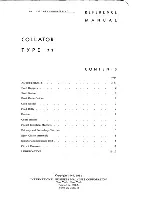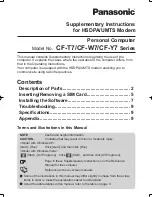
OLCT 700/710 TP
Page 6 of 45
Rev. C.1
OLCT 700/710 TP Instruction Manual
2.2
Functional Safety (SIL 2)
Refer to safety user manual NP700TPSMEN
2.3
Detector Placement
Selection of detector location is critical to the overall safe performance of the product. Six factors play an
important role in selection of detector locations:
(1) Density of the gas to be detected
(2) Most probable leak sources within the industrial process
(3) Ventilation or prevailing wind conditions
(4) Personnel exposure
(5) Maintenance access
(6) Additional Placement Considerations
Density
Placement of detectors relative to the density of the target gas is such that detectors for the detection of
heavier than air gases should be located within 4 feet of grade as these heavy gases will tend to settle in
low lying areas. For gases lighter than air, detector placement should be 4-8 feet above grade in open areas
or in pitched areas of enclosed spaces.
Note:
H
2
S is heavier than air.
Leak Sources
The most probable leak sources within an industrial process include flanges, valves, and tubing
connections of the sealed type where seals may either fail or wear. Other leak sources are best determined
by facility engineers with experience in similar processes.
Ventilation
Normal ventilation or prevailing wind conditions can dictate efficient location of gas detectors in a manner
where the migration of gas clouds is quickly detected.
Personnel Exposure
The undetected migration of gas clouds should not be allowed to approach concentrated personnel areas
such as control rooms, maintenance or warehouse buildings. A more general and applicable thought toward
selecting detector location is combining leak source and perimeter protection in the best possible
configuration.
Maintenance Access
Consideration should be given to providing easy access for maintenance personnel. Consideration should
also be given to the consequences of close proximity to contaminants that may foul the sensor prematurely.
NOTE:
In all installations the gas detector should point straight down (refer to Figure 7).
Improper detector orientation may result in false readings and permanent detector damage.
Additional Placement Considerations
The detector should not be positioned where it may be sprayed or coated with surface contaminating
substances. Painting detector assemblies is prohibited.
Although the detector is designed to be RFI resistant, it should not be mounted in close proximity to high-
powered radio transmitters or similar RFI generating equipment.
Summary of Contents for 700 TP Series
Page 6: ...OLCT 700 710 TP vi OLCT 700 710 TP This page has been left blank intentionally...
Page 20: ...OLCT 700 710 TP Page 14 of 45 Rev C 1 OLCT 700 710 TP Instruction Manual...
Page 46: ...OLCT 700 710 TP Page 40 of 45 Rev C 1 OLCT 700 710 TP Instruction Manual...
Page 48: ...OLCT 700 710 TP Page 42 of 45 Rev C 1 OLCT 700 710 TP Instruction Manual...













































